Lima
Lima
Lima
The Peruvian capital is a millennial city in which you can find hundreds of historical monuments. Lima has a delightful bay, surrounded by the waters of the Pacific, its colonial past impregnated in every piece of architecture that adorns it, and a multifaceted origin that is evident in every corner.
The City of the Kings is also renowned for its medley of cultures, ethnicities and customs that make it one of the most diverse cities in the world. It is precisely this mixture that has made Lima the Culinary Capital of South America. Lima’s culinary traditions are the fruit of the widespread intermingling of cultures – from Peru and many other countries. These traditions, when combined with the ingredients of a country as biodiverse as Peru, have given rise to cuisine that won it Best Culinary Destination at the World Travel Awards 7 consecutive times.
A testament to its quality and creativity, Lima is home to three of the World’s 50 Best Restaurants and ten of the 50 Best Restaurants in Latin America, according to the prestigious San Pellegrino List. This majestic city shows its hospitality by welcoming tourists and visitors from around the globe with its most emblematic dish, Peruvian ceviche. It also gladly receives all those who love nightlife, culture, art and its age-old past: it should be recalled that Caral, one of the oldest civilizations in history and the oldest in the Americas, took shape in Lima.
Location
Central coast of Peru
Elevation
min.: 3 meters (Ancón)
max.: 861 meters (Chosica)
Climate
Temperature
Summer:Max.: 26,1 °C Min.: 20,5 °C
Winter:Max.: 18 °C Min.: 15,2 °C
Arriving
By land
From the northern and southern coasts via the Panamericana Highway.
From the mountains and central jungle via the Central Highway.
By air
Regular flights from the country’s main cities and from overseas all arrive at Jorge Chávez International Airport (Callao), approximately 30 minutes from the center of Lima.
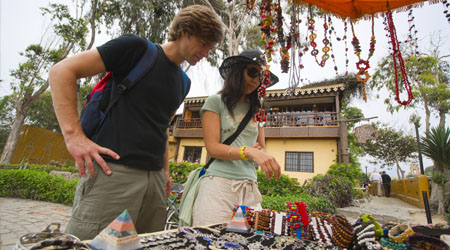
What to buy?
Everything the visitor could wish to purchase can be found in Lima. There are representative items from all corners of the country in the handcraft markets of Miraflores and Pueblo Libre. In shopping centers there is a wide range of products and national and international brands. Fine and modern alpaca and vicuña garments, as well as antiques and works of art can be obtained from exclusive stores along Avenida La Paz and Kennedy Park in Miraflores.
What to eat?
Peru has been named Best Culinary Destination in the World for six consecutive years (2012-2017), and Lima is known as the gastronomic capital of Latin America, because it brings together and enriches coastal, Andean, and jungle traditions. A number of its restaurants figure among the best in the world (50 Best). The creativity and the skills of its chefs play an important role in this success, but so do the variety and the freshness of the ingredients.
Signature dishes such as lomo saltado (beef stir fry) express this union, while ceviche, arroz con mariscos (rice with shellfish) and conchitas a la chalaca (scallops cooked in lemon) are dishes that pay tribute to the ocean that bathes the city. It is impossible to visit the city without trying at least one of its varied dishes, such as ají de gallina (shredded spicy chicken with walnuts, potatoes, and rice), anticuchos (beef skewers), causa (potato salad stuffed with vegetables or seafood), cau cau (tripe stew), and desserts such as the suspiro a la limeña (caramel meringue) or picarones (sweet fritter with syrup).
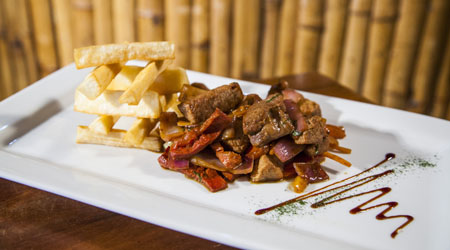
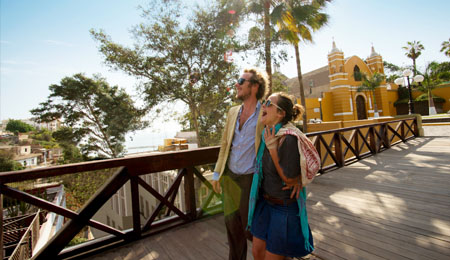
Tours (3 days the mínimum recommended)
Historic center: Main square, Cathedral, convents, churches, and museums.
San Isidro, Miraflores, and Barranco: archeological areas, museums, and parks.
Pueblo Libre tourist route: Plaza Bolívar; National Museum of Archeology, Anthropology and History of Peru; Santa María Magdalena Church; and Larco Museum.
Santiago de Surco tourist route: Gold of Peru and Weapons of the World museums, Voices for the Climate Park and Friendship Park.
Lurín and Pachacámac: Pachacamac Archeological Sanctuary and Peruvian Paso Horse display.
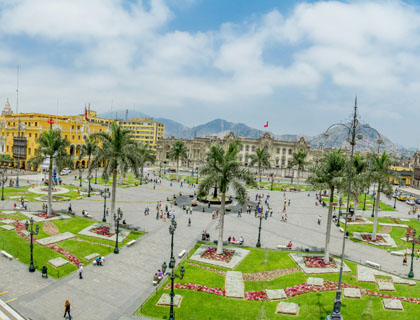
Lima Historic Center
The Historical Center of Lima is a World Heritage Site by UNESCO, thanks to its architectural and historical richness.
The patrimonial sector is conformed by what is known as "Square Lima" or "El Damero de Pizarro".
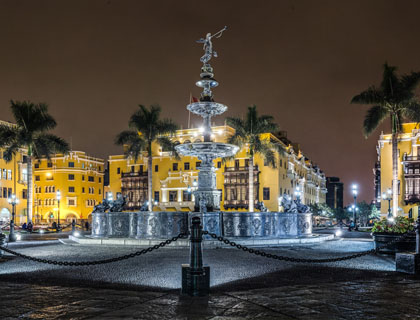
The Main Square
Located in the heart of Pizarro’s Checkerboad, this square is surrounded by the Cathedral, the Government Palace, and City Hall. A 17th century bronze fountain is one of its features.
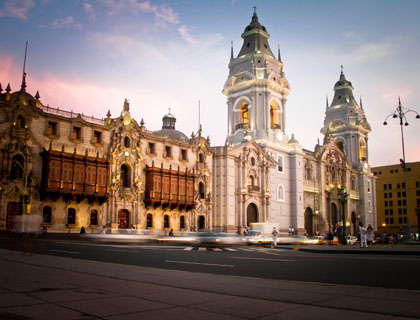
Basilica Cathedral and the Archbishop’s Palace Museum
Location: Main Square.
Visiting Hours: Mon-Fri: 09:00 - 17:00 hrs / Sat: 10:00-13:00 hrs (Basilica Cathedral) / 09:00 - 13:00 hrs (the Archbishop’s Palace Museum) / Sun: 13:00 - 17:00 hrs. (except the Archbishop’s Palace Museum).
Ticket entry.
The Cathedral stands on the foundations of an earlier church. In addition to works of art, it holds the remains of Francisco Pizarro and houses the Museum of Religious Art. The Archbishop’s Palace Museum has a collection composed of paintings, sculptures, and liturgical ornaments dating from between the 16th and 19th centuries.
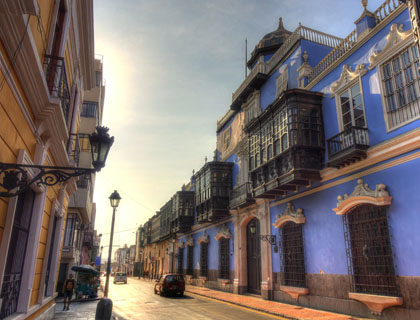
Jirón Áncash
A number of beautiful buildings are located on the second block of Jirón Ancash, particularly the houses of Trece Puertas, Rastro, Mendoza, and Balcón Ecléctico.
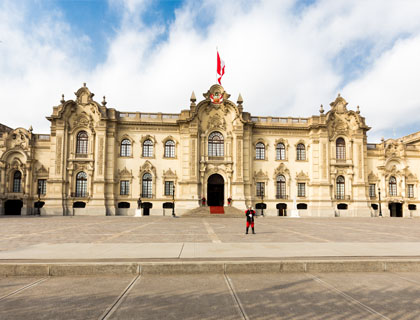
Government Palace
Location: Main Square.
Visiting Hours: Sat-Sun: 09:00 and 09:45 hrs.
Prior arrangement by telephone: (01) 311 3908 / 311 3900, extension 4308 / 4309.
Also known as the House of Pizarro for having been the site where the conqueror settled in 1535, this building is the center of political power in the country. The current structure was built in the 1920s. The halls named after important figures in Peruvian history. The changing of the guard can be seen at 11:45 am each day in the Courtyard of Honor.
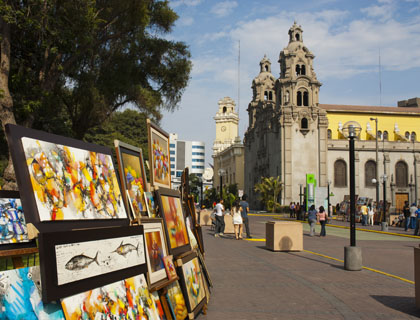
Miraflores: Miraflores Central Park
Location: Between Avenida Larco and Avenida Diagonal.
Formed by two parks, Parque 7 de Junio and Kennedy Park, this green space is one of the emblematic sites of Miraflores. It contains the Chabuca Granda Amphitheater. Visitors can consume traditional Lima desserts and wander along a path where painters exhibit their work.
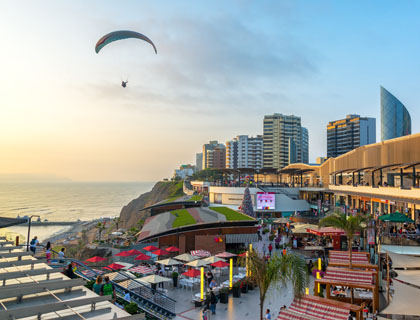
Miraflores: Larcomar
Located in Salazar Park, Larcomar is a modern shopping center with an unparalleled view of the Pacific Ocean. It has shops, restaurants, and a theater.
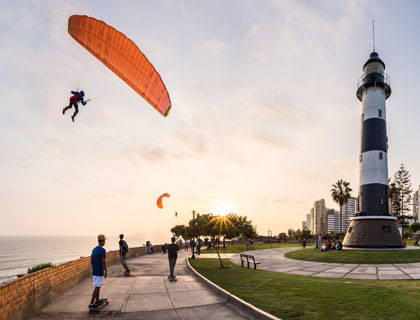
Miraflores: Miraflores Cliff Walk
Lining the edge of the cliff and with a beautiful views of the bay of Lima, this pathway is a perfect place to walk alone or with pets, and for leisure activities such as skateboarding, cycling, yoga classes, juggling, and roller-skating. Paragliding is also possible at a point along the way. Along the cliff walk there are several restaurants and a shopping center (Larcomar), and open parks such as the lighthouse, María Reiche and Parque del Amor (Park of Love) stand out. The visitor will also come across sculptures by important artists such as Fernando de Szyszlo and José Tola.
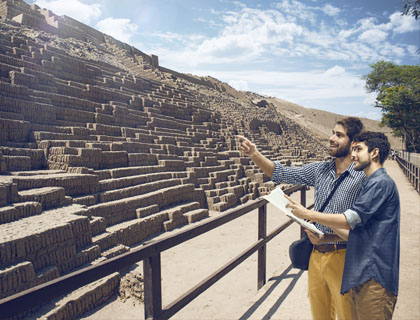
Miraflores: Huaca Pucllana
Location: Calle General Borgoño (8th block).
Visiting Hours: Wed-Mon: 09:00 – 17:00 hrs / Wed-Sun: 19:00 – 22:00 hrs.
Ticket entry.
Between the years AD 200 and 700, the Lima culture occupied this area and their adobe ceremonial and administrative center is testimony to their dominance. Pieces found during the excavations are on display in an exhibition hall. There is also a restaurant.
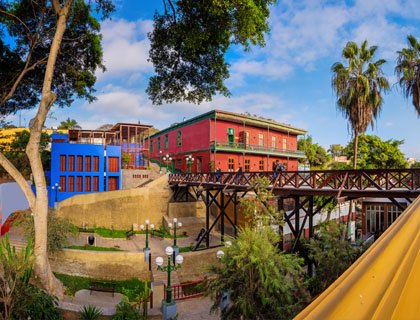
Barranco: Bridge of Sighs
Location: From the Barranco Main Square via the Chabuca Granda Passage. From Avenida San Martín via the Bajada de Baños.
Traditionally a place where people in love come to meet, this bridge was originally constructed in 1876 but was rebuilt after the War of the Pacific. It inspires musicians and poets. A path (la Bajada de Baños) beneath the bridge provides a wonderful view of the ocean and was used by fishermen to reach the water.
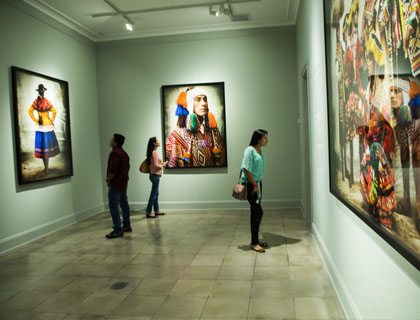
Barranco: Mario Testino Museum
Location: Avenida Pedro de Osma 409.
Visiting Hours: Tues-Sun: 10:00 - 19:00 hrs.
Ticket entry.
The work of the renowned Peruvian photographer, Mario Testino, is on permanent exhibition at this museum. It also houses temporary exhibitions of the work of other national and international artists.

Nearby destinations:
Pachacamac Archeological Sanctuary
Location: Old Panamericana Highway (South), 31.5 km (45 min. by car).
Visiting Hours: Tues-Sat: 09:00 - 16:30 hrs / Sun: 09:00 - 15:30 hrs.
Ticket entry.
The most important ceremonial center on the Peruvian coast consists of palaces, squares and temples made of mud, all constructed at different times. During the period of Inca rule these formed part of the Acllawasi and the Temple of the Sun. The archaeological center has a modern museum that explains the site’s importance in prehispanic history. From the top of Pachacamac, and when the sky is clear, the visitor can see the mythical island of Cavillaca, where legend evokes a princess and her son who were lost in the sea.
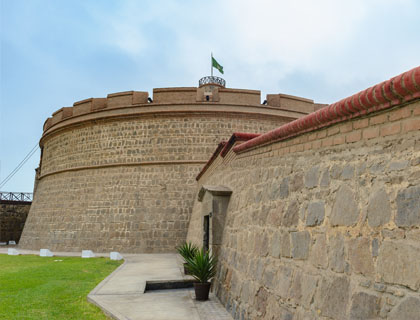
Callao: Real Felipe Fortress
Location: Plaza Independencia s/n Avenida Sáenz Peña (block 1).
Visiting Hours: Mon-Sun: 09:00 - 16:00 hrs.
Tel.: (01) 429 0532 / 465 8394.
Ticket entry.
One of the largest fortresses on the continent, Real Felipe was built in 1747 to defend the capital of the Vice royalty from attacks by pirates. On 2 May 1866, it was the site of a fierce battle in the war with Spain. It can be toured as part of a visit to the Peruvian Army Museum, which displays uniforms and weapons.

Callao: Islands
Sea lions, guano birds, a mysterious center of moon worship and an old prison are all part of the experience of visiting the Palomino islet and the islands of Cavinzas, San Lorenzo, and El Frontón. The nature and history of Callao can be enjoyed on four-hour cruises that depart from the quays of Callao and La Punta between 10 am and 2 pm.
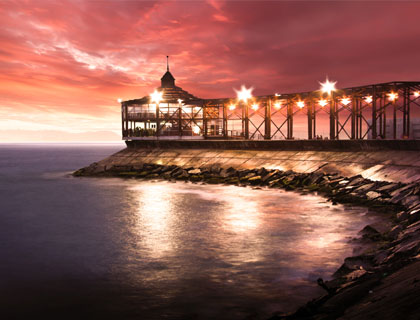
Callao: La Punta
This resort occupies the end of the peninsula of Callao. Republican-style mansions still remain. Marine cuisine can be enjoyed in the restaurants that line the boardwalk beside its pebbly beach and cold waters.



